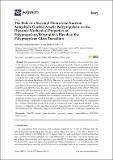Por favor, use este identificador para citar o enlazar a este item:
http://hdl.handle.net/10261/215713COMPARTIR / EXPORTAR:
 SHARE SHARE
 CORE
BASE CORE
BASE
|
|
| Visualizar otros formatos: MARC | Dublin Core | RDF | ORE | MODS | METS | DIDL | DATACITE | |

| Título: | The Role of a Succinyl Fluorescein-Succinic Anhydride Grafted Atactic Polypropylene on the Dynamic Mechanical Properties of Polypropylene/Polyamide-6 Blends at the Polypropylene Glass Transition |
Autor: | García-Martínez, Jesús María CSIC ORCID; Collar, Emilia P. CSIC ORCID | Palabras clave: | PA6/iPP Blends Glass transition Interfacial agents Compatibilizers aPP-SFSA DMA Wastes |
Fecha de publicación: | 27-may-2020 | Editor: | Multidisciplinary Digital Publishing Institute | Citación: | Polymers 12(6): 1216 (2020) | Resumen: | The present article adequately supports a twofold objective. On one hand, the study of the dynamic mechanical behavior of polypropylene/polyamide-6 blends modified by a novel compatibilizer was the objective. This was previously obtained by chemical modification of an atactic polypropylene polymerization waste. On the other hand, the accurate predictions of these properties in the experimental space scanned was the objective. As a novelty, this compatibilizer contains grafts rather than just maleated ones. Therefore, it consists precisely of an atactic polymer containing succinic anhydride (SA) bridges and both backbone and terminal grafted succinyl-fluorescein groups (SFSA) attached to the atactic backbone (aPP-SFSA). Therefore, it contains 6.2% of total grafting (2.5% as SA and 3.7% as SF), which is equivalent to 6.2 × 10−4 g·mol−1. This interfacial agent was uniquely designed and obtained by the authors themselves. Essentially, this article focuses on how the beneficial effect of both PA6 and aPP-SFSA varies the elastic (E’) and the viscous (E’’) behavior of the iPP/aPP-SFSA/PA6 blend at the iPP glass transition. Thus, we accurately measured the Dynamic Mechanical Analysis (DMA) parameters (E’, E’’) at this specific point considering it represents an extremely unfavorable scenario for the interfacial modifier due to mobility restrictions. Hence, this evidences the real interfacial modifications caused by aPP-SFSA to the iPP/PA6 system. Even more, and since each of the necessary components in the blend typically interacts with one another, we employed a Box–Wilson experimental design by its marked resemblance to the “agent-based models”. In this manner, we obtained complex algorithms accurately forecasting the dynamic mechanical behavior of the blends for all the composition range of the iPP/aPP-SFSA/PA6 system at the glass transition of iPP. | Descripción: | © 2020 by the authors. | Versión del editor: | https://doi.org/10.3390/polym12061216 | URI: | http://hdl.handle.net/10261/215713 | DOI: | 10.3390/polym12061216 | E-ISSN: | 2073-4360 |
| Aparece en las colecciones: | (ICTP) Artículos |
Ficheros en este ítem:
| Fichero | Descripción | Tamaño | Formato | |
|---|---|---|---|---|
| Role_Garcia_Art_2020.pdf | 3,34 MB | Adobe PDF |  Visualizar/Abrir |
CORE Recommender
PubMed Central
Citations
2
checked on 10-abr-2024
WEB OF SCIENCETM
Citations
4
checked on 24-feb-2024
Page view(s)
103
checked on 22-abr-2024
Download(s)
102
checked on 22-abr-2024

